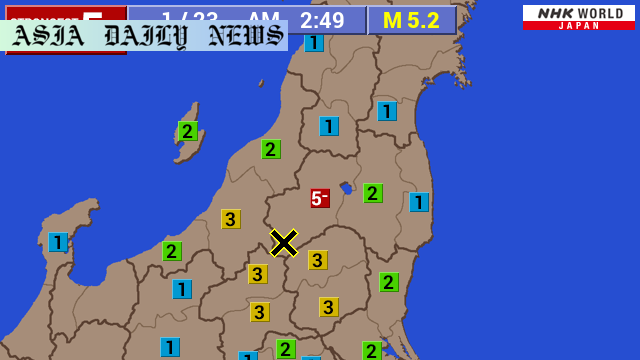A 5.2 magnitude earthquake shakes Fukushima Prefecture with no reported damage or tsunami warnings, officials confirm.
- A magnitude 5.2 earthquake struck Fukushima Prefecture early Thursday.
- No tsunami threat or reports of damage have been filed.
- Authorities report no changes to nuclear radiation levels in the area.

Early Morning Earthquake Hits Fukushima Prefecture
In the early hours of Thursday, at 2:49 a.m., a magnitude 5.2 earthquake struck Fukushima Prefecture, situated in northeastern Japan. This sudden seismic activity was confirmed by the Japan Meteorological Agency, which noted that the quake’s focus was at a relatively shallow depth of 4 kilometers. Initially, the quake was reported as a magnitude 5.0 with a focus depth of 10 kilometers, but updated estimates revealed the revised intensity and depth.
No Tsunami Threat or Damage Reported
Fortunately, officials have confirmed there is no immediate threat of a tsunami following the quake. Additionally, as of 3:15 a.m., local police and the fire department in the region reported no damage in Hinoemata Village, the area that experienced an intensity of lower 5 on Japan’s seismic scale of zero to 7. This scale measures the earthquake’s impact on structures and people, rather than just its magnitude.
Reassurances Regarding Nuclear Plant Safety
The Tokyo Electric Power Company (TEPCO) has thoroughly evaluated its nuclear facilities following the event. TEPCO confirmed that there are no abnormalities at the Fukushima Daiichi and Daini nuclear power plants. Additionally, monitoring posts around the nuclear facilities indicated no significant changes in radiation levels, reassuring residents about their safety.
Ongoing Analysis by Meteorological Experts
The Japan Meteorological Agency continues to monitor seismic activity in the region. Although this quake did not result in widespread havoc, it serves as a reminder of the persistent earthquake risks in Japan, one of the most seismically active countries in the world. Experts are analyzing data to help predict and mitigate potential impacts from future quakes.
The Importance of Preparedness
Japan’s thorough earthquake monitoring system and early warning mechanisms once again prove their effectiveness. The lack of widespread damage and absence of casualties show how consistent investments in disaster mitigation strategies pay off. Residents in earthquake-prone regions are encouraged to maintain emergency preparedness, including having supplies and evacuation plans ready. Local authorities have reiterated the importance of being vigilant even in the absence of immediate damage.
Global Attention on Fukushima’s Safety
Fukushima, unfortunately associated with the devastating 2011 earthquake and tsunami that caused the nuclear disaster, remains under close international observation. The region’s ability to handle such seismic events with efficiency and safety demonstrates progress in resilience and recovery. Global stakeholders continue to watch the region’s efforts to secure its infrastructure and reduce risks posed by natural disasters.
A Calm After the Shake
While this earthquake did not escalate into a catastrophic event, it serves as a sobering reminder that nature is unpredictable. Japanese authorities and citizens collectively maintain a high level of vigilance and preparedness. As of now, the region can breathe a temporary sigh of relief, knowing that the systems in place are effectively protecting lives and critical infrastructure.



Commentary
The Resilience of Fukushima Amid Seismic Activity
Japan’s commitment to disaster management and public safety is truly commendable. This latest earthquake in Fukushima, though minor in its impact, emphasizes the importance of preparation. As a geographically volatile area, Japan continuously faces seismic challenges, and its approach to minimizing risks is a model for the world. From early warning systems to robust safety protocols, Japan invests heavily in safeguarding its residents—and it shows.
Nuclear Safety: A Reassuring Outcome
Whenever an earthquake impacts Fukushima Prefecture, global concern inevitably shifts to the safety of the region’s nuclear plants. These facilities have a history tied to one of the world’s worst nuclear disasters, which lingers in collective memory. This recent quake reaffirmed that stringent safety measures and continuous monitoring are vital, and the measures implemented by authorities are yielding positive outcomes. From unchanged radiation levels to proactive inspections, transparency and safety have fostered a sense of security among residents and observers alike.
A Global Call for Preparedness
The Fukushima earthquake underscores the broader need for preparedness globally. Earthquakes, tsunamis, and other natural disasters can occur with little warning, emphasizing the value of emergency response systems. Nations worldwide, especially those in seismic zones, need to evaluate their infrastructure and public safety mechanisms. While the devastation was averted in this instance, it is a moment to assess and strengthen collective disaster resilience strategies.
Events like these remind us that vigilance, science, and community preparedness are our strongest allies against nature’s unpredictability.